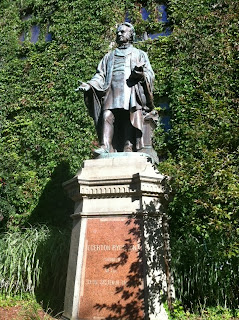- The amount of American student debt recently surpassed the amount of American credit card debt for the first time since the fed started keeping track of this data in 2003. There are real and potential problems with this, best explained by someone more qualified than me.
- At the same time student indebtedness is increasing, the economic landscape remains uncertain. Taking out a loan for college presumes that you'll make enough money after college to pay the loan down without sacrificing too much of your quality of life. Getting a job that fits that criteria is not a guarantee.
- Higher education costs are continuing to rise substantially above the rate of inflation
- Mean family income has decreased over the last ten years
- State and federal contributions to public universities are being cut, forcing many universities to find other sources of revenue (in many cases, through increased tuition)
- Cost is a relative term, and must be differentiated from price
- The actual cost is frequently less for a family than the college's stated "sticker" price
- So long as financial aid is boosted too, some tuition increases lead to increased enrollment activity. Prospective families, they find, would prefer generous aid and a high sticker price than that the college cut tuition.
- In some cases, they project enrollment to drop when colleges cut their tuition price
I also have some concerns. Full-pay families receiving no aid are crucial in this model. Presumably, the money used to increase need-based aid is coming at least partly from the increased revenue of these full-pay families being asked to pay more. Even if you incentivize this group with discounts in the form of merit aid, at some point, won't these families stop being willing to pay? And if/when that happens, where does the aid money come from to continue funding the needy families? Relying on full or high-paying families to provide generous aid to the needy also ends up boxing out the middle class - a problem the presenters acknowledged.
But here's the biggest problem: A model that predicts enrollment increases at rising tuition costs (so long as aid is provided), ignores the type of information asymmetry that exists between savvy college-going populations and those that are most vulnerable. For many of the neediest, most under-served communities, sticker price does matter. I would argue - and research backs this up - that high sticker prices can scare away the neediest students. Moreover, complex financial aid applications are often a deterrent to these under-served populations. If a college increases cost and financial aid in an effort to boost enrollment, it should be very aware of what types of students compose that increased enrollment. They are likely to be students who are savvy enough to understand that the sticker price isn't the same as the cost, and who are comfortable navigating the financial aid application. They almost certainly won't be the high-achieving, low-income and first-gen kids for whom elite, expensive colleges claim to be (and ought to be) working to provide access.
In short, the fundamental idea here is that tuition increases are acceptable because people understand that their individual cost will likely be something less than the sticker price. I don't think that's something that all prospective families understand; I think that's something that traditional college-going populations understand. And that ignores a major underrepresented socioeconomic demographic, within which there are indeed many high-achieving kids who never consider going to college at all, let alone one perceived to be prohibitively expensive.
I would be interested in finding out which colleges and universities have used the model prescribed by Art and Science Grp, and to see 1) if their enrollment indeed increased; 2) if that increase was disproportionately made up of upper-middle class kids; and 3) if the increase in sticker price preceded a decrease in applications from low-income students. If the answer is yes to questions 2 and/or 3, a college interested in socioeconomic diversity ought to question the ethics of the model. Boosting financial aid is the right idea. But I'm afraid many families who need that aid frequently aren't college-savvy enough to see beyond the sticker price and understand how increased aid could help them.











